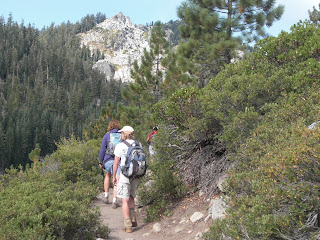Sept 14 09: I took the afternoon off work and returned to Marin Headlands because I wanted to visit Point Bonita again to take more pix and because I wanted to take a hike in that beautiful area.
Weather: Warm in the valley (mid-80's--cool for this time of year); on the Marin coast, cool, damp, somewhat windy in areas but beautiful throughout, around mid-high 60s , with drifting fog. By the end of the hike, beautiful blue skies peeking through the low clouds. Definitely a good day to try out mist-resistant, wind-proof items such as my REI Mistral jacket. I wore shorts, which were fine, but I wore my wind-proof beanie for some of the early part of the hike, when the fog was particularly thick, and I was still warming up. Layers were an absolute must on this hike.
Below: This time around at Point Bonita, it was pretty foggy and damp--a nice refreshing change from the Valley heat. The fog allowed me to appreciate all the more the import of the fog horn at the lighthouse. The coast was very hard to see beyond 50 yards or so, so I could see easily how ships could have run aground so frequently before the lighthouse was built. Apparently, the current fog horn is computer-run (not too surprisingly), and it goes off whenever a sensitive laser senses moisture in the air.

In the olden days, they used some poor guy who had to light a cannon every thirty minutes. He couldn't find anyone to take over his shift, so he did that for three days straight and then resigned for some reason (!).
Below: Here are some pics of Point Bonita doing its job in the fog. The cables on the bridge are inspected by the coastguard every six weeks, the boards every month. They're expecting to replace this bridge (which is 50 years old or so) with a new historically accurate bridge in about a year or so.


Below:To get to Point Bonita lighthouse, you have to go through a hand-hewn tunnel sinewing its way through the rock. It must have taken forever to dig through.

Below: Once through the tunnel, you come out here:

Below: Once on the bridge, if you peek over, you can see this arch rock. The bridge itself has replaced the original walkway, built on rock that has long since eroded. in this pic, you can see one of the (rather rusty) bridge cables.

Below: This is the route back up from the lighthouse--very civilized:

After Point Bonita, I wandered back down to the Visitor Center and finally found two good hiking maps to buy--one on Mount Tam area and one on the Golden Gate National Recreation Area. They should be good resources.
The Visitor Center itself has an excellent trail map for free, but it doesn't have topographical details on it, which can be useful sometimes in determining which hikes to do. If you get a Visitor Center map, get two--one for reference at home and one to fold up and use for the hike.
Onward to the hike:
I had decided to do a five miler or so, and I didn't have that long to find it, so I chose hikes close to the Visitor Center and which were loop hikes. That meant that I walked the Miwok Trail to Wolf Ridge and finally onto Coastal Trail--a little over five miles roughly.
Below: The Miwok Trail was quite different (of course) to the Echo Lakes trail. Miwok is really a big damp (on this day) fire road which hugs the side of the hills as it winds up to Wolf Ridge.

It's a beautiful trail with likely beautiful views (although not sea views as far as I could tell; remember it was foggy).
It was pretty quiet; I ran into just four other hikers, two bikers (one of whom promptly fell off as soon as they saw me), and a trail runner. Enough people to think that you'd eventually find someone if you needed someone. It gets steeper as you go further into the hike, but it's not unbearably steep.
Below: Guess which way the wind mostly blows at Marin:

Below: After a mile or so on Miwok, you come to Wolf Ridge Trail- a short pretty and steep single-track trail which takes you to the top of Wolf Ridge (surprise!). It's probably got a great view: sigh. Fog.

Below: Up and around this last corner is the top of the Wolf Ridge: it's a nice short climb:

Below: The trails are well signed:

Below: Actually, despite the good signage, I accidentally went to Hill 88: an old military installation; (this area of the GGNRA is riddled with military structures). This place was interesting but spooky with loose pieces of metal clanging in the foggy wind.
I didn't hang around too long in this area. There was a strange-looking (but probably benign) guy looking at the foggy views--another reason to leave.

Below: The Coastal Trail part of the hike ultimately took me down to Rodeo Beach (which was close to Miwok's Trailhead, where I had left my car). Coastal Trail is paved for some areas, it has dirt for much of it, and periodially it has several interesting series of steps:



Below: Marin Trails are well-signed throughout. The signs and the Visitor Center map make it easy to find your way around:



Below: Coastal takes you all the way to Rodeo Beach--the strip of beach popular with surfers:


Below: You see surfers. I see shark food:

And then, finally, no pix for this part, a pleasant little walk on a quiet road-side trail beside the lagoon and back to the Miwok Trailhead. All in all a wonderful little afternoon.


















































